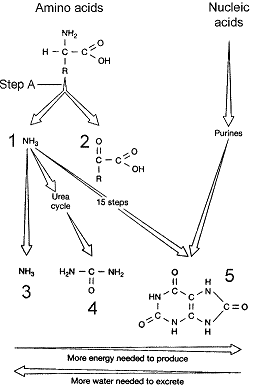A) protonephridia are involved in osmoregulation, while metanephridia are involved in excretion.
B) protonephridia consist of blind flame cells, while metanephridia consist of tubules open at both ends.
C) protonephridia are involved in excretion, while metanephridia are involved in osmoregulation.
D) protonephridia consist of tubules open at both ends, while metanephridia consist of blind flame cells.
E) protonephridia are found in annelids and metanephridia are found in flatworms.
G) A) and E)
Correct Answer

verified
Correct Answer
verified
True/False
Birds store most of their waste nitrogen as uric acid .
B) False
Correct Answer

verified
Correct Answer
verified
Multiple Choice
When you drink a large volume of water, the release of ____ by the pituitary gland ____.
A) aldosterone; increases
B) aldosterone; decreases
C) ADH; increases
D) ADH; decreases
E) ANP; increases
G) None of the above
Correct Answer

verified
Correct Answer
verified
Matching
Match the part of the human urinary system with its description.
Correct Answer
True/False
Blood flows from the efferent arterioles directly into the peritubular capillaries .
B) False
Correct Answer

verified
Correct Answer
verified
Essay
Compare and contrast the osmoregulatory challenges and solutions used by sharks and freshwater fishes.
Correct Answer

verified
Freshwater fishes live in a hypotonic en...View Answer
Show Answer
Correct Answer
verified
View Answer
Matching
Match the term below with its definition/description.
Correct Answer
Matching
Match the excretory structure with its description or animal
Correct Answer
Multiple Choice
The secretion of ____ is an important homeostatic mechanism involved in maintaining normal heart rhythm.
A) hydrogen ions
B) potassium ions
C) water
D) glucose
E) urea
G) C) and E)
Correct Answer

verified
Correct Answer
verified
Multiple Choice
The ureters connect the:
A) bladder to the body exterior.
B) kidney to the bladder.
C) bladder to the urethra.
D) kidney to the body exterior.
E) kidney to the urethra.
G) A) and C)
Correct Answer

verified
Correct Answer
verified
Matching
Match the part of the human urinary system with its description.
Correct Answer
Matching
Match the part of the human urinary system with its description.
Correct Answer
Multiple Choice
Which of the following would be secreted across the tubule?
A) sodium ions
B) vitamins
C) creatinine
D) carbon dioxide
E) glucose
G) B) and E)
Correct Answer

verified
Correct Answer
verified
Multiple Choice
Osmoconformers would most likely be found in:
A) estuaries.
B) coastal zones that receive freshwater.
C) freshwater.
D) terrestrial habitats.
E) open ocean waters.
G) A) and C)
Correct Answer

verified
Correct Answer
verified
Multiple Choice
Figure 48-1  Which structure in the accompanying figure represents the nitrogenous waste urea?
Which structure in the accompanying figure represents the nitrogenous waste urea?
A) 1
B) 2
C) 3
D) 4
E) 5
G) A) and C)
Correct Answer

verified
Correct Answer
verified
True/False
Most reabsorption occurs in the distal convoluted tubule .
B) False
Correct Answer

verified
Correct Answer
verified
Multiple Choice
What is the function of antidiuretic hormone?
A) It increases the permeability of the collecting ducts to sodium so more is reabsorbed.
B) It causes a high volume of less concentrated urine to be produced.
C) It increases aldosterone secretion.
D) It decreases renin secretion.
E) It increases the permeability of the collecting ducts to water so more is reabsorbed.
G) C) and D)
Correct Answer

verified
Correct Answer
verified
Matching
Match the term below with its definition/description.
Correct Answer
True/False
ADH makes the walls of the collecting duct more permeable to water .
B) False
Correct Answer

verified
Correct Answer
verified
Matching
Match the waste product with its description or the animal that excretes it.
Correct Answer
Showing 41 - 60 of 111
Related Exams